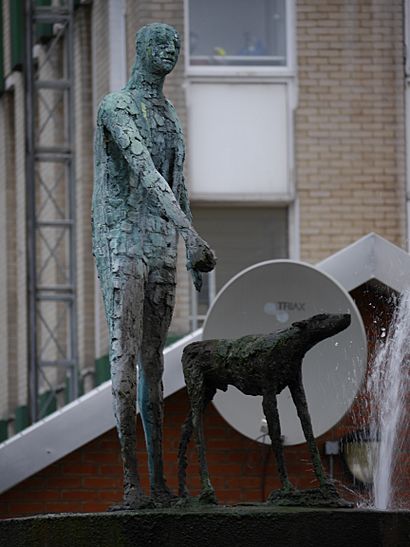Blind Beggar and His Dog facts for kids
Quick facts for kids Blind Beggar and His Dog |
|
|---|---|
 |
|
| Artist | Elisabeth Frink |
| Completion date | 1958 |
| Type | Sculpture |
| Medium | Bronze |
| Subject | The Blind Beggar |
| Dimensions | 2.4 m (8 ft) |
| Location | Cranbrook Estate, Bethnal Green, London |
| 51°31′47″N 0°02′42″W / 51.5298°N 0.0449°W | |
|
Listed Building – Grade II
|
|
| Official name | Blind Beggar and his dog, Cranbrook Estate |
| Designated | 15 April 1998 |
| Reference no. | 1031598 |
The Blind Beggar and his Dog is a cool bronze statue made in 1958. It was created by the famous sculptor Elisabeth Frink. You can find it in a peaceful garden at Tate House. This is a place where older people live in the Cranbrook Estate in Bethnal Green, London. This sculpture is so important that it's a Grade II* listed structure. This means it's a special historic building or monument.
The Story Behind the Statue
Have you ever heard of the legend of the Blind Beggar? This old story became very popular during the Tudor period in England. There are many different versions of the tale.
One popular story tells of a brave English knight named Simon de Montford. He was blinded during a big battle called the Battle of Evesham in 1265. After losing his sight, he became very poor. He had to beg for money in Bethnal Green.
Simon had a beautiful daughter named Besse. Four young men wanted to marry her. Three of them gave up when they thought her father couldn't offer a dowry (money or gifts given at a wedding). But the fourth suitor saw how kind and noble Besse was. He decided to marry her anyway! It turned out that the beggar's own father was still very rich. So, Besse received a dowry after all.
This legend is very important to Bethnal Green. The town's coat of arms even shows pictures of Besse and her blind father. Many places in the area are named after this old story.
How the Statue Was Made
After World War II, many parts of Bethnal Green needed to be rebuilt. The area had been badly damaged. A team of architects helped design new housing estates. The Cranbrook estate was the biggest of these new housing areas.
In 1957, the Bethnal Green Council decided to have a sculpture made. They chose Elisabeth Frink, who was only 27 years old at the time, to create the statue of the Blind Beggar.
The sculpture was first placed on Roman Road. You could still see it from there. But in 1963, it was moved to its planned home in Tate Garden. That's where it stands today.
What the Statue Looks Like
The statue is made of bronze and stands 8 feet tall. That's about as tall as two grown-ups! It stands on a special stone base made of different layers.
People who have seen the statue often say it looks both "vulnerable" and "serious." It's a powerful piece of art. In 1998, it was officially given a Grade II* heritage listing. This means it's recognized as a very important part of history and art.

